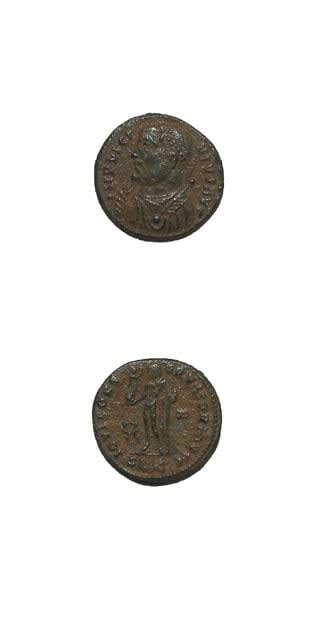Bronze Coin of Emperor Licinius, 308 CE - 324 CE
Bronze
C.4342
Obverse: IMP LICINIVS AVG; Diademed, Draped, and Cuirassed Bust of the Emperor Facing Lef Reverse: IOVI CONSERVATORI; Jupiter Standing to the Left, Holding Victory and a Sceptre, a Wreath in...
Obverse: IMP LICINIVS AVG; Diademed, Draped, and Cuirassed Bust of the Emperor Facing Lef
Reverse: IOVI CONSERVATORI; Jupiter Standing to the Left, Holding Victory and a Sceptre, a Wreath in the Field to the Left
Born of Illyrian peasant stock, Licinius advanced in the army and was suddenly elevated to the rank of Augustus by his friend, Emperor Galerius. Galerius hoped to have him rule the West, but since Italy, Africa, and Spain were held by the usurper Maxentius, while Constantine reigned in Gaul and Britain, Licinius had to content himself with ruling Pannonia. When Galerius died in 311, Licinius took over Galerius' European dominions. In 313, he married Constantine's half sister Constantia and defeated the Eastern emperor Maximinus who shortly thereafter died. Licinius thus added the entire eastern half of the empire to his dominion. During the campaign against Maximinus, Licinius had made his army use a monotheistic form of prayer closely resembling that later imposed by Constantine. On June 5, 313, he had issued an edict granting tolerance to the Christians and restoring church property.
How many hands have touched a coin in your pocket or purse? What eras and lands have the coin traversed on its journey into our possession? As we reach into our pockets to pull out some change, we rarely hesitate to think of who might have touched the coin before us, or where the coin will venture to after it leaves our hands. More than money, coins are a symbol of the state that struck them, of a specific time and location, whether contemporary currencies or artifacts of a long forgotten empire. This stunning hand-struck coin reveals an expertise of craftsmanship and intricate sculptural detail that is often lacking in contemporary machine-made currencies. This ancient coin is a memorial an emperor’s reign passed from the hands of civilization to civilization, from generation to generation that still appears as vibrant today as the day it was struck.
Reverse: IOVI CONSERVATORI; Jupiter Standing to the Left, Holding Victory and a Sceptre, a Wreath in the Field to the Left
Born of Illyrian peasant stock, Licinius advanced in the army and was suddenly elevated to the rank of Augustus by his friend, Emperor Galerius. Galerius hoped to have him rule the West, but since Italy, Africa, and Spain were held by the usurper Maxentius, while Constantine reigned in Gaul and Britain, Licinius had to content himself with ruling Pannonia. When Galerius died in 311, Licinius took over Galerius' European dominions. In 313, he married Constantine's half sister Constantia and defeated the Eastern emperor Maximinus who shortly thereafter died. Licinius thus added the entire eastern half of the empire to his dominion. During the campaign against Maximinus, Licinius had made his army use a monotheistic form of prayer closely resembling that later imposed by Constantine. On June 5, 313, he had issued an edict granting tolerance to the Christians and restoring church property.
How many hands have touched a coin in your pocket or purse? What eras and lands have the coin traversed on its journey into our possession? As we reach into our pockets to pull out some change, we rarely hesitate to think of who might have touched the coin before us, or where the coin will venture to after it leaves our hands. More than money, coins are a symbol of the state that struck them, of a specific time and location, whether contemporary currencies or artifacts of a long forgotten empire. This stunning hand-struck coin reveals an expertise of craftsmanship and intricate sculptural detail that is often lacking in contemporary machine-made currencies. This ancient coin is a memorial an emperor’s reign passed from the hands of civilization to civilization, from generation to generation that still appears as vibrant today as the day it was struck.



